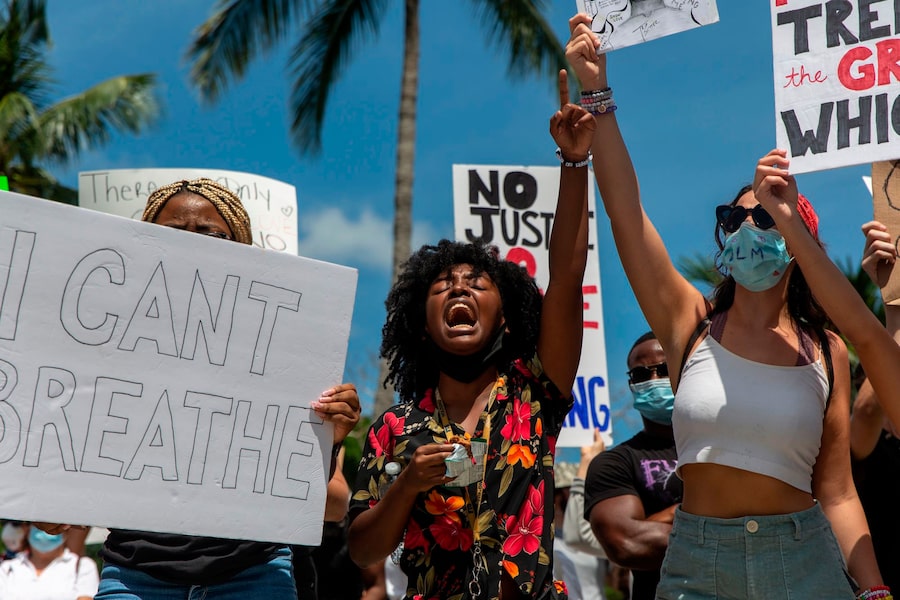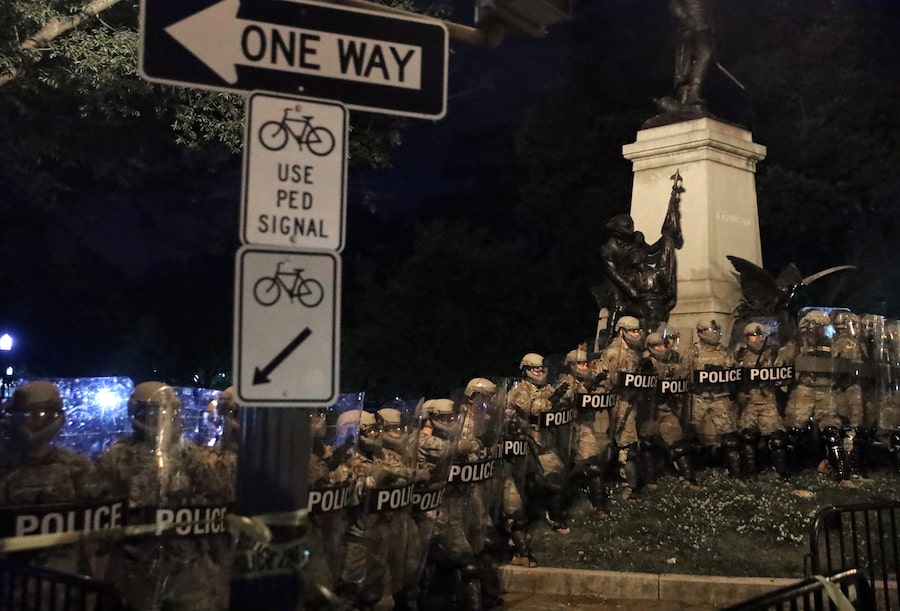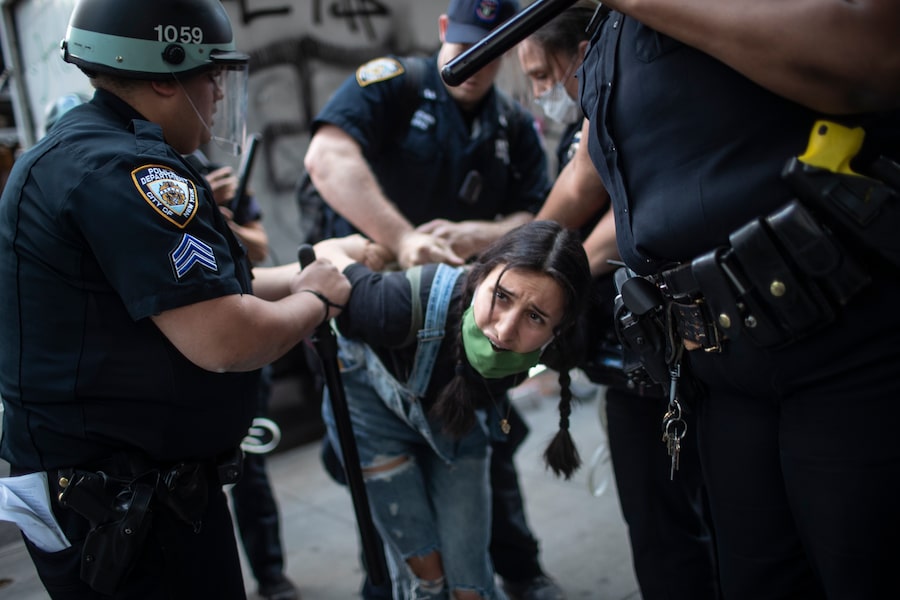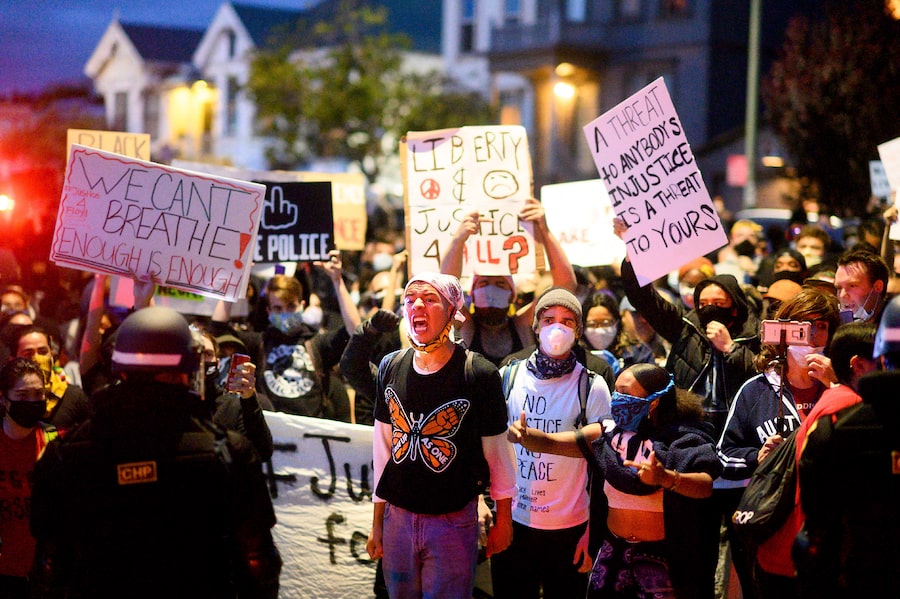Americans began cleaning up charred and glass-strewn streets Sunday after another night of unrest fuelled by rage over police mistreatment of African Americans destroyed businesses, damaged landmarks and raised tensions across a divided nation to the boiling point.
The chaos reached into every corner of the country, and the scars extended even to buildings near the White House. Some elected officials prepared to deploy additional National Guard troops in anticipation of more turmoil.
Tens of thousands of people marched peacefully to protest the death of George Floyd, a black man who died Monday after a white Minneapolis police officer pressed his knee on his neck until he stopped breathing. But many demonstrations sank into violence as night fell: Cars and stores were torched. The words “I can’t breathe” were spray-painted all over buildings. Police responded with tear gas and rubber bullets.
Related stories
Minneapolis police officer charged with murder in death of George Floyd
Opinion: America is burning – and with good reason
The scale of the protests, sweeping from coast to coast and unfolding on a single night, rivalled the historic demonstrations of the civil rights and Vietnam eras. And by Sunday morning, the fury had spread to Europe, where thousands gathered in London’s Trafalgar Square, clapping and waving placards despite government rules barring crowds because of the COVID-19 pandemic.
“We’re sick of it. The cops are out of control,” protester Olga Hall said in Washington, D.C. “They’re wild. There’s just been too many dead boys.”
People set fire to squad cars, threw bottles at officers and broke storefront windows. They carried away TVs and other merchandise even as some protesters urged them to stop. In Indianapolis, two people were reported dead after multiple shootings that happened during downtown violence. Those slayings added to deaths reported in Detroit and Minneapolis in recent days.
In Minneapolis, the city where the protests began, police, state troopers and National Guard members moved in soon after an 8 p.m. curfew took effect to break up the demonstrations. The show of force came after three days in which police largely avoided engaging protesters, and after the state poured more than 4,000 National Guard troops into Minneapolis. Authorities said that number would soon rise to nearly 11,000.
President Donald Trump appeared to cheer on the tougher tactics, commending the National Guard deployment in Minneapolis and declaring “No games!” He said police in New York City “must be allowed to do their job!”
Presumptive Democratic presidential nominee Joe Biden condemned the violence as he continued to express common cause with those demonstrating after Floyd’s death.
“The act of protesting should never be allowed to overshadow the reason we protest,” Biden said in a late-night statement.

Demonstrators clash as people gather to protest the death of George Floyd, Saturday, May 30, 2020, near the White House in Washington. Floyd died after being restrained by Minneapolis police officers.Evan Vucci/The Associated Press
On Sunday, maintenance crews near the White House worked to replace windows that had been shattered with large pieces of wood. Buildings for blocks were marked with graffiti, including curses about Trump and anti-police sentiments. Shattered glass still covered the sidewalks. The damaged buildings included the Department of Veterans Affairs, directly across the street from the White House.
At the Minneapolis intersection where Floyd was killed, people gathered with brooms and flowers, saying it was important to protect what they called a “sacred space.” The intersection was blocked with the traffic cones while a ring of flowers was laid out.
County Commissioner Angela Conley showed up shortly after the curfew lifted, saying that police had trampled flowers and photos of Floyd. “The community needs healing, and what happened last night only exacerbated the pain that’s been felt,” she said of police action.
Conley said the demonstrations and confrontations with police would continue until the other three officers who were at the scene when Floyd was pinned down are arrested and prosecuted. The officer who put his knee on Floyd’s neck, Derek Chauvin, was charged last week with murder. All four officers have been fired.
“We’ll continue to have this militarized presence in our community until justice is done,” Conley said.
Meanwhile, a church located at the intersection set up chairs for an outdoor service. Tracy Gordon, of the Worldwide Outreach for Christ, said it was important “to bring some hope to the community and let everyone know that God is in control.”
Few parts of America were untouched, from protesters setting fires inside Reno’s city hall, to police launching tear gas at rock-throwing demonstrators in Fargo, North Dakota. In Salt Lake City, demonstrators flipped a police car and lit it on fire. Police said six people were arrested and an officer was injured after being struck in the head with a baseball bat.
Protesters demonstrate in Columbia, S.C., in response to the recent killing of George Floyd in Minnesota at the hands of law enforcement, May 30, 2020. Former Vice President Joe Biden, the presumptive Democratic presidential nominee, wants to heal the soul of the country in this moment of protest and loss, and win the White House. Simply telling people to vote in November may not help with either goal.Sean Rayford/The New York Times News Service
Overnight curfews were imposed in more than a dozen major cities nationwide, including Atlanta, Denver, Los Angeles, Minneapolis, San Francisco and Seattle.
At least 13 police officers were injured in Philadelphia, and at least four police vehicles were set on fire. In New York City, dangerous confrontations flared repeatedly as officers made arrests and cleared streets. A video showed two NYPD cruisers lurching into a crowd of demonstrators who were pushing a barricade against one of them and pelting it with objects. Several people were knocked to the ground. It was unclear if anyone was hurt.
“The mistakes that are happening are not mistakes. They’re repeated violent terrorist offences, and people need to stop killing black people,” Brooklyn protester Meryl Makielski said.
Some leaders prepared to put more soldiers in the streets by evening. Georgia Gov. Brian Kemp authorized the deployment of up to 3,000 National Guard troops to Athens, Savannah and any other cities where more demonstrations were planned. Kemp had already approved up to 1,500 Guardsmen to help enforce a 9 p.m. Saturday curfew in Atlanta.
“The protesters need to know we’re going to support their efforts in a peaceful, nonviolent protest,” the Republican told television station WSB late Saturday. “The agitators need to know that we’ll be there … to take them to jail if they’re destroying lives and property.”
In Virginia’s capital city, graffiti invoking Floyd or directing slurs at the police dotted downtown, including many of Richmond’s prominent Confederate monuments. At the headquarters of the United Daughters of the Confederacy, which news outlets reported was vandalized and set ablaze, a few men with long guns were among a small crowd gathered outside. One man said they were there to protect the building.
In Ferguson, Missouri, where Michael Brown Jr. was shot and killed by a white police officer in 2014, sparking a wave of protests throughout the country, six officers were hurt by thrown rocks and fireworks.
Police have arrested nearly 1,700 people in 22 cities since Thursday, according to a tally by The Associated Press. Nearly a third of those arrests came in Los Angeles, where the governor declared a state of emergency and ordered the National Guard to back up the city’s 10,000 police officers as dozens of fires burned across the city.
This week’s unrest recalled the riots in Los Angeles nearly 30 years ago after the acquittal of the white police officers who beat Rodney King, a black motorist who had led them on a high-speed chase. The protests of Floyd’s killing have gripped many more cities, but the losses have yet to approach the staggering totals Los Angeles saw during five days of rioting in 1992, when more than 60 people died, 2,000-plus were injured and thousands arrested, with property damage topping $1 billion.
Demonstrator stands on top of a damaged NYPD vehicle during a protest against the death in Minneapolis police custody of George Floyd, in Manhattan, New York, U.S., May 30, 2020.ANDREW KELLY/Reuters









